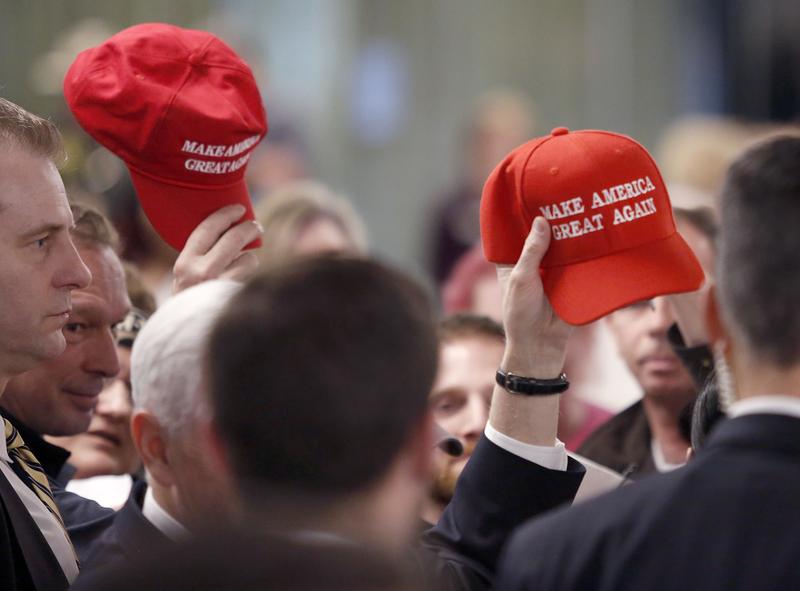BOB GARFIELD: It was an episode that began as a thumbnail and became a meme–smirking kid in MAGA hat nose to nose with drummer. CNN contributor Angela Rye.
[CLIP]
ANGELA RYE: Just think about the symbol of that Red Hat. This Make America Great Again hat is just as maddening and frustrating and triggering for me to look at as a KKK hood. [END CLIP]
BOB GARFIELD: White hood? Really? That bad? Jeannine Bell is a hate crime scholar and a professor at Indiana University’s Maurer School of Law. She says, 'hold on.'
JEANNINE BELL: There are particular signs that are universal. The Klan is a sign that's universal.
BOB GARFIELD: But there are other powerful symbols for which the meaning is in the eyes of the beholder.
JEANNINE BELL: Individuals who wear MAGA hats see them as supporting the idea that America should be made great again. It's not necessarily linked with this idea of white supremacy. Others see the MAGA hats as the racial hatred that was invoked, at particular times, by members of the Republican Party. In that way, the MAGA hat is a very complicated sign. It's not a straightforward sign that you get with something like a Klan hood.
BOB GARFIELD: Another way of saying that might be Rorschach test.
JEANNINE BELL: Right, exactly. Some people see two faces. Some people see a vase.
BOB GARFIELD: When I see them, I have a visceral, you know, sort of flinch. It's a big red hot, red flag for me. It puts me on my guard being prepared to expect the worst. Does the fault lie in me?
JEANNINE BELL: No. There's certainly been rhetoric attached to the hat that suggests violence. The rhetoric during the campaign that involved pummeling protesters suggests that not all ideas are welcome.
BOB GARFIELD: And yet, it's also not a smoking gun.
JEANNINE BELL: It is also not a smoking gun.
BOB GARFIELD: And yet, the Internet blew up with outrage over what was perceived as the smoking gun of racism, of privilege, of white oppression. So was that unfair?
JEANNINE BELL: Everyone's entitled to a view informed by their perspective–absolutely entitled. So I don't think fair versus unfair is the right way to see this. I also think that we all live in the same world, right? And it's important for us to be honest with each other about the impressions that we're creating when we engage with one another. So individuals who put on the hats, they know how others see them. They have a sense of this. These are polarized times where we talk about things. They may decide to wear them anyway, and that's of course their right. But this is not surprising that one might see the wearing of this hat as an invocation of racism.
BOB GARFIELD: Let me ask you this, if those kids have been wearing Kentucky Wildcat hats, you'd think we'd be even having this conversation?
JEANNINE BELL: I do not think that we would be having these conversations at all.
BOB GARFIELD: There were hundreds or thousands or I don't know what number of people who had seen everything they needed to see in the first frame of the Lincoln Memorial encounter. Is there enough evidence in that single frame for anyone, no matter what their worldview, to draw a conclusion.
JEANNINE BELL: You're not going to be able to get a witness on this one or a good tape on this one because I haven't seen the video.
BOB GARFIELD: You're the only American, I think, who has not.
JEANNINE BELL: I study hate crimes. So I have more interest in it because I do it for work than most people. And I haven't watched it. It's been across my Facebook feed 50,000–No. No. I know what the first frame, however, is like because that's what, you know, it's the cover in all the--
BOB GARFIELD: It's the thumbnail.
JEANNINE BELL: Right.
BOB GARFIELD: So if I were to assert, because I--and I believe it, that first frame close to the case for a lot of people.
JEANNINE BELL: Right.
BOB GARFIELD: I just want you to characterize that reaction to that kid, the hat, the smirk, the whole deal. Was it enough evidence to be drawing conclusions?
JEANNINE BELL: As a scholar, that's my perspective, that one picture does not allow you to draw conclusions.
BOB GARFIELD: Jeannine, thank you very much.
JEANNINE BELL: Thank you so much for having me.
BOB GARFIELD: Jeannine Bell is a hate crimes scholar and professor at Indiana University's Maurer School of Law. Her latest book is Hate Thy Neighbor: Move-In Violence and the Persistence of Racial Segregation in American Housing.


